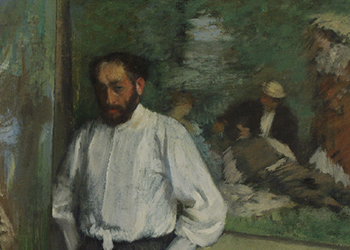The Visible and Invisible in the Work of Edgar Degas

Portrait of Henri Michel-Lévy
The painting Portrait of Henri Michel-Lévy (c. 1878) is one of the most enigmatic works in the Calouste Gulbenkian Museum. The complex construction of its composition – raises countless questions and suggests multiple possible readings. Presented at the fourth impressionist exhibition (1879), the work was displayed with the title Artist in his Studio.
The representation focuses on Henri Michel-Lévy, painter and friend of the artist, whom Degas met in 1867. Both painters were enthusiastic art collectors and, during that period, carried out their respective portraits. The theme of ‘artist in the studio’ had been visited before in Degas’ work, as in 1868 the artist painted Portrait of James Tissot, in which the theme of ‘painting within a painting’ emerges, as it does here.
The composition develops in an unexpected space of representation, where the painter, through elements cleverly enclosed in distinct segments of the pictorial space, simultaneously reveals and hides (himself). To the right, we can see an updated version of the fête galante in impressionist style, while on the left appears the painting The Regattas, which establishes a relationship between the mannequin on the floor and its representation on canvas. According to Reff, the composition seems to refer to an ‘original reading of the relationship between truth and illusion.’
Diverse interpretations have meanwhile been proposed and the question of the artist’s misogyny raised, revived here by the inanimate mannequin. Coming from a family of bankers, and with a solitary temperament, the painter found in woman, however, one of his great themes. He began to depict her in a family setting, then moving ‘behind the curtain’, to the opera, dance classes, brothels.
The artist (who, for Degas, should not have a personal life) is thus someone who should act as a cold observer of reality, never sentimentalising it. For this reason, he stated: ‘women hate me, I show them without their coquetry, in the state of animals.’ The depictions he made of his pupil Mary Cassatt suggest, however, a more prudent reading of the theme.
Heavily influenced by Titian and Ingres, Degas was, simultaneously, it should be stressed, a classical painter and a breakaway artist. In portraying with cruelty that which Baudelaire called the ‘modern life’, Degas found in his painting, in fact, a new version of real, a ‘mental’ real.
This composition, which simultaneously incorporates a life cycle (the suggestion of joie de vivre) and the revelation of death (Michel-Lévy’s box of paints, where a doll lying next to the palette suggests the half open lid of a coffin), seeks, above all, to represent human isolation, a profoundly innovative aspect in the painter’s work, which led the novelist and critic Edmond Duranty to call him, during that period, the ‘inventor of social chiaroscuro.’
Luísa Sampaio